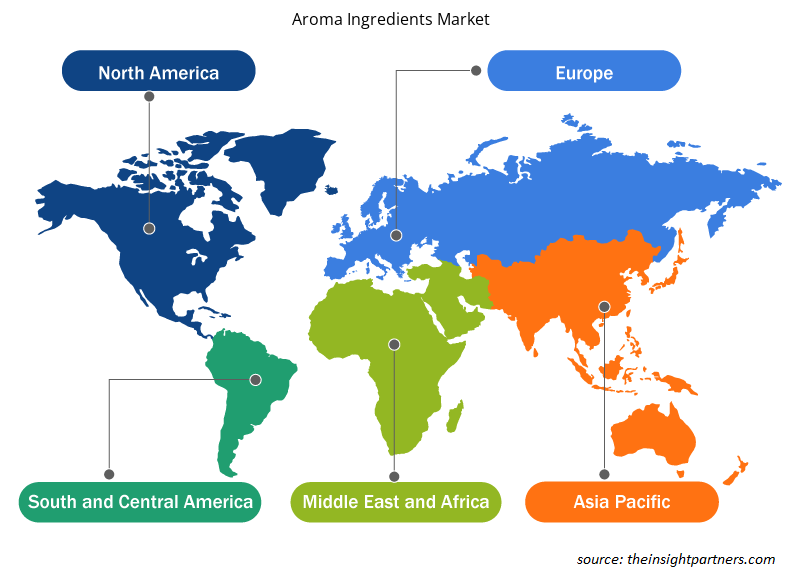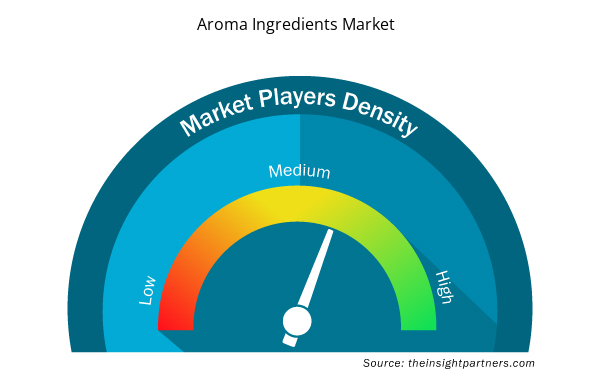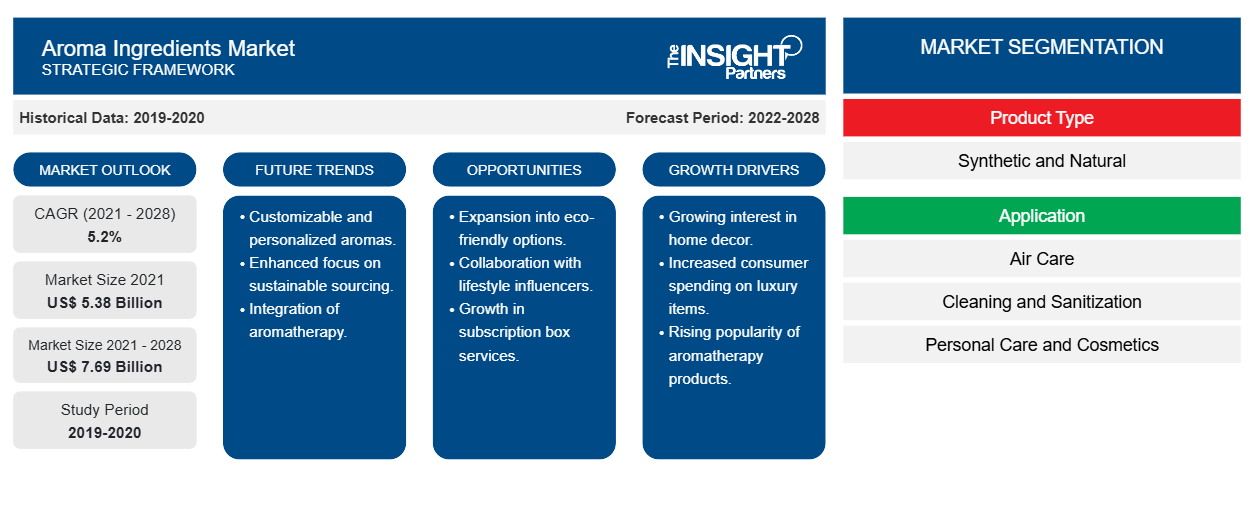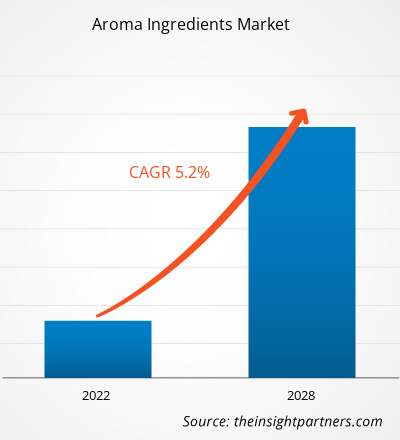香料原料市場は2021年に53億7,690万米ドルと評価され、2028年までに76億9,262万米ドルに達すると予測されており、 2021年から2028年にかけて5.2%のCAGRで成長すると予想されています。
アロマ成分は、基本的に、化粧品やパーソナルケア、ホームケア、その他の製品に添加され、望ましい香りを与える複雑な化合物です。アロマ成分は天然または合成です。アロマ成分には、エッセンシャルオイル、アタール、アイソレート、オレオレジン、アブソリュート、アロマケミカル、特殊アロマ成分などがあります。パーソナルケアおよび化粧品業界の変遷により、アロマ成分市場に数多くの新たな成長機会がもたらされ、予測期間中に市場を牽引すると予想されています。
2020年、アジア太平洋地域は世界のアロマ成分市場を支配し、予測期間中もその優位性を維持すると予想されています。近年、アジア太平洋地域の個人の間では外見に関する意識が高まっており、化粧品の需要が増加し、同地域の化粧品市場の成長につながっています。アジアの消費者の間では、見栄えの良い個人的なイメージを求める傾向が強く、個人の衛生習慣に対する意識が高まっています。消費者の健康と衛生に対する関心が高まるにつれ、香りやアロマを提供するパーソナルケア、化粧品、クリーニング、消毒製品の需要が増加し、アロマ成分の需要も増加しています。さらに、アジア太平洋地域は、アロマ成分を利用する数多くの最終用途市場の製造拠点となっているインドや中国などの国で構成されています。アジア太平洋地域の発展途上国の人口増加と可処分所得の増加により、パーソナルケア製品と化粧品の需要が増加しています。この需要により、パーソナルケア製品の国内生産が増加し、同地域でのアロマ成分の消費が増加しています。
要件に合わせてレポートをカスタマイズする
このレポートの一部、国レベルの分析、Excelデータパックなど、あらゆるレポートを無料でカスタマイズできます。また、スタートアップや大学向けのお得なオファーや割引もご利用いただけます。
- このレポートの主要な市場動向を入手してください。この無料サンプルには、市場動向から見積もりや予測に至るまでのデータ分析が含まれます。
市場分析
アロマ成分の様々な用途
エアケア、高級フレグランスや香水、家庭用品、食品や飲料、医薬品など、さまざまな用途でのアロマ成分の使用が増えているため、アロマ成分の需要が高まっています。高級フレグランスには、香水、コロン、ボディミスト、デオドラントなどの主要な用途があります。アロマ成分は、高級フレグランスの配合に使用される必須要素の1つです。これに加えて、クリーナー、ハンドソープや食器洗い液、洗濯用ケア製品や柔軟剤、ワイプ、水性染料などの家庭用品にもアロマ成分が使用されています。したがって、アロマ成分の用途の増加は、アロマ成分市場の成長を促進するでしょう。
製品タイプの洞察
製品タイプに基づいて、芳香成分市場は天然と合成に分かれています。2020年、天然セグメントは芳香成分市場で最も急速に成長したセグメントでした。合成化学物質に関連する健康上の懸念の増加により、消費者からの天然芳香成分の需要が高まっています。ただし、合成芳香成分は、すべてのバッチで同じ品質を維持しながら大規模に生産するのが比較的簡単です。合成成分の一貫した品質により、特に動きの速い消費財業界での広範な使用により、市場シェアが拡大しました。
高砂香料工業株式会社、BASF SE、Firmenich S.A.、Givaudan S.A.、International Flavors & Fragrances Inc.、Robertet Group、Symrise、Mane、Zhejiang NHU Co., Ltd.、およびPhoenix Aromas & Essential Oils, LLCは、芳香成分市場で活動している主要企業です。主要企業は、合併や買収、製品の発売など、地理的プレゼンスと消費者ベースを拡大するために、いくつかの戦略を採用しています。
アロマ原料市場の地域別分析
予測期間を通じてアロマ成分市場に影響を与える地域的な傾向と要因は、Insight Partners のアナリストによって徹底的に説明されています。このセクションでは、北米、ヨーロッパ、アジア太平洋、中東、アフリカ、南米、中米にわたるアロマ成分市場のセグメントと地理についても説明します。

- アロマ原料市場の地域別データを入手
アロマ成分市場レポートの範囲
| レポート属性 | 詳細 |
|---|---|
| 2021年の市場規模 | 53億8千万米ドル |
| 2028年までの市場規模 | 76億9000万米ドル |
| 世界のCAGR(2021年~2028年) | 5.2% |
| 履歴データ | 2019-2020 |
| 予測期間 | 2022-2028 |
| 対象セグメント | 製品タイプ別
|
| 対象地域と国 | 北米
|
| 市場リーダーと主要企業プロフィール |
|
アロマ成分市場のプレーヤー密度:ビジネスダイナミクスへの影響を理解する
アロマ成分市場は、消費者の嗜好の変化、技術の進歩、製品の利点に対する認識の高まりなどの要因により、エンドユーザーの需要が高まり、急速に成長しています。需要が高まるにつれて、企業は提供品を拡大し、消費者のニーズを満たすために革新し、新たなトレンドを活用し、市場の成長をさらに促進しています。
市場プレーヤー密度とは、特定の市場または業界内で活動している企業または会社の分布を指します。これは、特定の市場スペースに、その市場規模または総市場価値に対してどれだけの競合相手 (市場プレーヤー) が存在するかを示します。
アロマ原料市場で事業を展開している主要企業は次のとおりです。
- 高砂香料工業株式会社
- BASF SE
- フィルメニッヒSA
- ジボダンSA
- インターナショナル・フレーバーズ&フレグランス社
免責事項:上記の企業は、特定の順序でランク付けされていません。

- アロマ原料市場のトップキープレーヤーの概要を入手
レポートの注目点
- 香料原料業界の進歩的なトレンドは、プレーヤーが効果的な長期戦略を策定するのに役立ちます
- 先進国市場と発展途上国市場での成長を確保するために企業が採用する事業成長戦略
- 2019年から2028年までの世界の香料原料市場の定量分析
- さまざまな業界における香料原料の需要予測
- ポーター分析は、業界で活動するバイヤーとサプライヤーの有効性を示し、市場の成長を予測します。
- 競争的な市場シナリオと香料原料の需要を理解するための最近の動向
- 市場動向と展望、香料原料市場の成長を牽引・抑制する要因
- 世界的な香料原料市場の成長に関する商業的関心を支える戦略についての理解は、意思決定プロセスに役立ちます。
- 市場のさまざまなノードにおける香料原料の市場規模
- 世界のアロマ成分市場の詳細な概要とセグメンテーション、およびその業界動向
- 有望な成長機会のあるさまざまな地域のアロマ成分市場規模
「2028年までの世界のアロマ成分市場分析」は、世界のアロマ成分市場のトレンド分析に特に焦点を当てた、化学および材料業界の専門的かつ詳細な調査です。このレポートは、詳細な市場セグメンテーションで市場の概要を提供することを目的としています。アロマ成分市場は、製品タイプ、用途、および地域に基づいてセグメント化されています。製品タイプに基づいて、市場は天然と合成に分割されています。用途に基づいて、市場は空気ケア、クリーニングと消毒、パーソナルケアと化粧品、高級フレグランスと香水、その他に分割されています。地域に基づいて、市場は北米、ヨーロッパ、アジア太平洋、中東とアフリカ、南米と中米の5つの主要地域に分割されています。sanitization, personal care and cosmetics, fine fragrances and perfumes, and others. Based on geography, the market is segmented into five main regions—North America, Europe, Asia Pacific, the Middle East and Africa, and South and Central America.
企業プロフィール
- 高砂香料工業株式会社 International Corporation
- BASF SE SE
- フィルメニッヒSA S.A.
- ジボダンSA S.A.
- インターナショナル・フレーバーズ&フレグランス社
- ロベールグループ Group
- シムライズ
- たてがみ
- 浙江NHU株式会社NHU Co., Ltd.
- フェニックスアロマス&エッセンシャルオイルズ LLC.LLC.
- 過去2年間の分析、基準年、CAGRによる予測(7年間)
- PEST分析とSWOT分析
- 市場規模価値/数量 - 世界、地域、国
- 業界と競争環境
- Excel データセット



Report Coverage
Revenue forecast, Company Analysis, Industry landscape, Growth factors, and Trends

Segment Covered
This text is related
to segments covered.

Regional Scope
North America, Europe, Asia Pacific, Middle East & Africa, South & Central America

Country Scope
This text is related
to country scope.
よくある質問
Aroma ingredients are extensively used to create a wide range of fragrances. Increased healthcare awareness and disposable income have increased demand for consumer goods such as soaps, hand wash, sanitizers, detergents and toiletries. Although, the expansion of the personal care and household care industries significantly contributes to the growth of the aroma ingredient market. Manufacturers focus on increasing natural ingredients for the flavor and fragrance industry to ensure the sustainable sourcing of raw materials.
In 2020, the natural segment accounted for the fastest-growing segment. Natural aroma ingredients are extracted from natural sources, including wood, spices, flowers, and fruits. The rising awareness of the negative effects of synthetic ingredients on human health has increased the demand for natural and bio-based aroma ingredients.
Based on application, personal care and cosmetics are the fastest-growing segments. Aroma ingredients are extensively used in manufacturing personal care and cosmetics products. Continuous technological developments in the personal care and cosmetics sectors and innovations and research and development expenditures are expected to propel the growth of the aroma ingredient market.
In 2020, the synthetic segment accounted for the largest market share. Synthetic aroma ingredients can reproduce a natural and robust scent without compromising the fragrance to manufacture quality fragrance. It has strong demand in manufacturing soaps, shampoos, body lotions, hair conditioners, and other cosmetic and personal care products.
The major players operating in the global metakaolin market are Takasago International Corporation, BASF SE, Firmenich S.A., Givaudan S.A., International Flavors & Fragrances Inc., Robertet Group, Symrise, Mane, Zhejiang NHU Co., Ltd., and Phoenix Aromas & Essential Oils, LLC.
In 2020, Asia Pacific accounted for the largest share of the global aroma ingredient market. The aroma ingredient industry is anticipated to expand faster due to increasing awareness of personal care and hygiene.
Trends and growth analysis reports related to Chemicals and Materials : READ MORE..
The List of Companies - Aroma Ingredient Market
- Takasago International Corporation
- BASF SE
- Firmenich S.A.
- Givaudan S.A.
- International Flavors & Fragrances Inc.
- Robertet Group
- Symrise
- Mane
- Zhejiang NHU Co., Ltd.
- Phoenix Aromas & Essential Oils, LLC.
The Insight Partners performs research in 4 major stages: Data Collection & Secondary Research, Primary Research, Data Analysis and Data Triangulation & Final Review.
- Data Collection and Secondary Research:
As a market research and consulting firm operating from a decade, we have published and advised several client across the globe. First step for any study will start with an assessment of currently available data and insights from existing reports. Further, historical and current market information is collected from Investor Presentations, Annual Reports, SEC Filings, etc., and other information related to company’s performance and market positioning are gathered from Paid Databases (Factiva, Hoovers, and Reuters) and various other publications available in public domain.
Several associations trade associates, technical forums, institutes, societies and organization are accessed to gain technical as well as market related insights through their publications such as research papers, blogs and press releases related to the studies are referred to get cues about the market. Further, white papers, journals, magazines, and other news articles published in last 3 years are scrutinized and analyzed to understand the current market trends.
- Primary Research:
The primarily interview analysis comprise of data obtained from industry participants interview and answers to survey questions gathered by in-house primary team.
For primary research, interviews are conducted with industry experts/CEOs/Marketing Managers/VPs/Subject Matter Experts from both demand and supply side to get a 360-degree view of the market. The primary team conducts several interviews based on the complexity of the markets to understand the various market trends and dynamics which makes research more credible and precise.
A typical research interview fulfils the following functions:
- Provides first-hand information on the market size, market trends, growth trends, competitive landscape, and outlook
- Validates and strengthens in-house secondary research findings
- Develops the analysis team’s expertise and market understanding
Primary research involves email interactions and telephone interviews for each market, category, segment, and sub-segment across geographies. The participants who typically take part in such a process include, but are not limited to:
- Industry participants: VPs, business development managers, market intelligence managers and national sales managers
- Outside experts: Valuation experts, research analysts and key opinion leaders specializing in the electronics and semiconductor industry.
Below is the breakup of our primary respondents by company, designation, and region:

Once we receive the confirmation from primary research sources or primary respondents, we finalize the base year market estimation and forecast the data as per the macroeconomic and microeconomic factors assessed during data collection.
- Data Analysis:
Once data is validated through both secondary as well as primary respondents, we finalize the market estimations by hypothesis formulation and factor analysis at regional and country level.
- Macro-Economic Factor Analysis:
We analyse macroeconomic indicators such the gross domestic product (GDP), increase in the demand for goods and services across industries, technological advancement, regional economic growth, governmental policies, the influence of COVID-19, PEST analysis, and other aspects. This analysis aids in setting benchmarks for various nations/regions and approximating market splits. Additionally, the general trend of the aforementioned components aid in determining the market's development possibilities.
- Country Level Data:
Various factors that are especially aligned to the country are taken into account to determine the market size for a certain area and country, including the presence of vendors, such as headquarters and offices, the country's GDP, demand patterns, and industry growth. To comprehend the market dynamics for the nation, a number of growth variables, inhibitors, application areas, and current market trends are researched. The aforementioned elements aid in determining the country's overall market's growth potential.
- Company Profile:
The “Table of Contents” is formulated by listing and analyzing more than 25 - 30 companies operating in the market ecosystem across geographies. However, we profile only 10 companies as a standard practice in our syndicate reports. These 10 companies comprise leading, emerging, and regional players. Nonetheless, our analysis is not restricted to the 10 listed companies, we also analyze other companies present in the market to develop a holistic view and understand the prevailing trends. The “Company Profiles” section in the report covers key facts, business description, products & services, financial information, SWOT analysis, and key developments. The financial information presented is extracted from the annual reports and official documents of the publicly listed companies. Upon collecting the information for the sections of respective companies, we verify them via various primary sources and then compile the data in respective company profiles. The company level information helps us in deriving the base number as well as in forecasting the market size.
- Developing Base Number:
Aggregation of sales statistics (2020-2022) and macro-economic factor, and other secondary and primary research insights are utilized to arrive at base number and related market shares for 2022. The data gaps are identified in this step and relevant market data is analyzed, collected from paid primary interviews or databases. On finalizing the base year market size, forecasts are developed on the basis of macro-economic, industry and market growth factors and company level analysis.
- Data Triangulation and Final Review:
The market findings and base year market size calculations are validated from supply as well as demand side. Demand side validations are based on macro-economic factor analysis and benchmarks for respective regions and countries. In case of supply side validations, revenues of major companies are estimated (in case not available) based on industry benchmark, approximate number of employees, product portfolio, and primary interviews revenues are gathered. Further revenue from target product/service segment is assessed to avoid overshooting of market statistics. In case of heavy deviations between supply and demand side values, all thes steps are repeated to achieve synchronization.
We follow an iterative model, wherein we share our research findings with Subject Matter Experts (SME’s) and Key Opinion Leaders (KOLs) until consensus view of the market is not formulated – this model negates any drastic deviation in the opinions of experts. Only validated and universally acceptable research findings are quoted in our reports.
We have important check points that we use to validate our research findings – which we call – data triangulation, where we validate the information, we generate from secondary sources with primary interviews and then we re-validate with our internal data bases and Subject matter experts. This comprehensive model enables us to deliver high quality, reliable data in shortest possible time.


 このレポートの無料サンプルを入手する
このレポートの無料サンプルを入手する